鄱阳湖国家级自然保护区东方白鹳Ciconiaboyciana-Bioline
洞庭湖国家级自然保护区鸟类名录
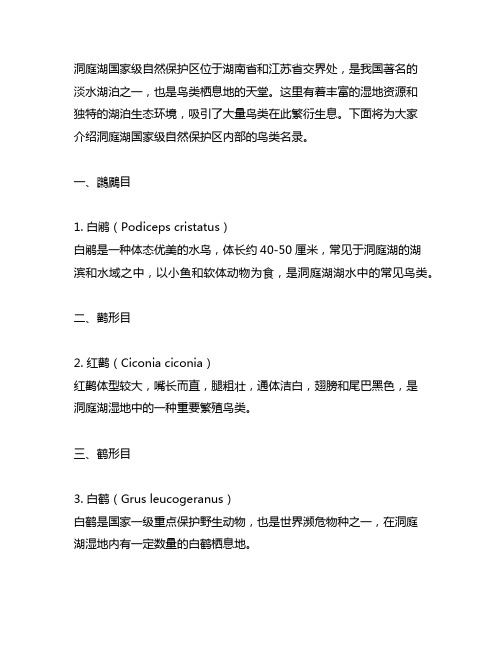
洞庭湖国家级自然保护区位于湖南省和江苏省交界处,是我国著名的淡水湖泊之一,也是鸟类栖息地的天堂。
这里有着丰富的湿地资源和独特的湖泊生态环境,吸引了大量鸟类在此繁衍生息。
下面将为大家介绍洞庭湖国家级自然保护区内部的鸟类名录。
一、鸊鷉目1. 白鹇(Podiceps cristatus)白鹇是一种体态优美的水鸟,体长约40-50厘米,常见于洞庭湖的湖滨和水域之中,以小鱼和软体动物为食,是洞庭湖湖水中的常见鸟类。
二、鹳形目2. 红鹳(Ciconia ciconia)红鹳体型较大,嘴长而直,腿粗壮,通体洁白,翅膀和尾巴黑色,是洞庭湖湿地中的一种重要繁殖鸟类。
三、鹤形目3. 白鹤(Grus leucogeranus)白鹤是国家一级重点保护野生动物,也是世界濒危物种之一,在洞庭湖湿地内有一定数量的白鹤栖息地。
4. 大雁(Anser anser)大雁是冬季洞庭湖湿地内的候鸟,常见于湖边、草地和田间,是观鸟者喜爱的鸟类。
五、鸥形目5. 普通鸬鹚(Phalacrocorax carbo)鸬鹚是一种身材修长、颈长嘴尖的水鸟,经常在洞庭湖湿地内觅食。
六、鸠形目6. 绿头鸠(Treron phoenicoptera)绿头鸠是一种体态优雅的中型鸟类,尤其是在洞庭湖湿地周边的树林内,绿头鸠常可见到。
七、隼形目7. 燕隼(Falco rusticolus)燕隼是一种优秀的捕食者,它在洞庭湖湿地内的草原和湖边常可见到,以大型昆虫和小型鸟类为食。
8. 白尾海雕(Haliaeetus leucoryphus)白尾海雕是洞庭湖湿地内的特有鸟类,属于国家二级保护动物,喜欢在湖水中觅食,飞翔时极具观赏价值。
以上是洞庭湖国家级自然保护区内部的一部分鸟类名录,这里拥有优越的生态环境和丰富的鸟类资源,为鸟类研究者和观鸟爱好者提供了绝佳的观测和研究条件。
希望在未来我们能够更加努力地保护这一片美丽的湿地,让这里的鸟类得到更好的生存和繁衍条件。
洞庭湖国家级自然保护区内的鸟类资源丰富,鸟类的多样性和数量使这里成为了鸟类研究者和观鸟爱好者的天堂。
行走鹤乡——鄱阳湖鸟类保护区考察记

虽 然 是 雨 过 天 睛 ,但 道 路 依 旧 泥 泞 ,不一 会 鞋 子 便沾 满 了 厚 厚 的泥 浆 ,
协 会 在 中 国 实 施 的 一 个 开 发 项 目 ,该
塘湖泊 中 发现 栖息 着的 水鸟 ,种类还 真不 少 !三 五只鸬 鹚 ( 即鱼鹰 )和 夹
杂 在 其 中 的 一 两 只 大 白 鹭 ,俨 然 构 成 了 一 幅 国 画 !停 下 脚 步 ,用 望 远 镜 耐 心 观 察 ,突 然 发 现 一 只 麦 鸡 正 在 热 烈 地 求 偶 , 热 恋 中 的 这 对 麦 鸡 面 对 着 面 , 以 嘴 相 啄 ,脖 子 一 屈 一 伸 ,进 发
一
路 上 ,我 们 还 看 到 了 白 头 鹤 、
灰 鹤 、凤 头鸦 、长脚 鹬 、黑尾塍 鹬 、
鹊 钨 、翠 乌 、棕 背 伯 劳 、野 鸭 等 。 这 里 是 鸟 的 天 堂 , 鸟 儿 们 各 自 诉 说 着 我 听 不 懂 的 语 言 , 生 活 在 我 所 不 了 解 的 另一 个 世 界 里 ,无 忧 无 虑 ,
通 过望 远镜 ,我 们真 真切 切地 观察到
了这种现象 。
离 开 大 湖 池 核 心 区 , 我 们 又 被
带 到 了 朱 市 湖 监 测 点 ,在 用 于 监 测 的 嘹 望 亭 里 ,借 助 望 远 镜 ,我 们 幸 运 地 发 现 了 三 只 白 羽 黑 尾 、正 专 注 觅 食 的 东 方 白 鹳 , 白 鹳 和 白 鹤 的 生 活 习 性 相
我 这个初 来乍到 的异 乡客 人抖漏一 下
本 领 ,好 比 失 事 的 飞 机 一 样 笔 直 往 下 落 ,速 度 惊 人 ,等 到 降 到 我 头 顶 上 方
附 近 ,又 再 次拉 升 飞 起 !
鄱阳湖国家级自然保护区鸟类名录
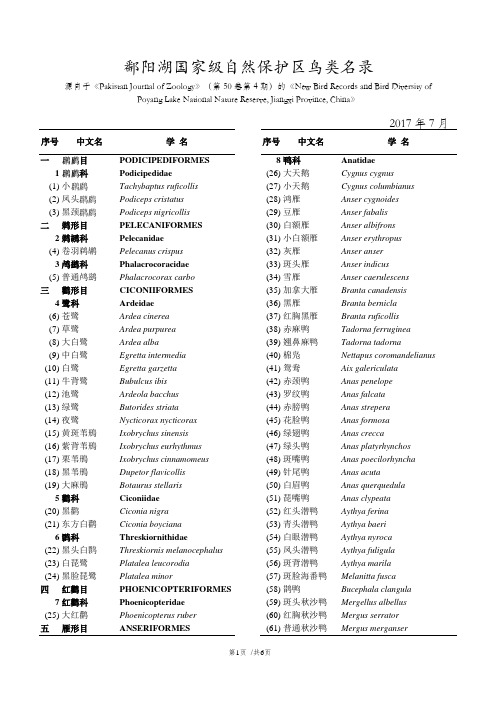
鄱阳湖国家级自然保护区鸟类名录源自于《Pakistan Journal of Zoology》(第50卷第4期)的《New Bird Records and Bird Diversity of Poyang Lake National Nature Reserve, Jiangxi Province, China》2017年7月序号中文名学名一目PODICIPEDIFORMES1 Podicipedidae(1) 小Tachybaptus ruficollis(2) 凤头Podiceps cristatus(3) Podiceps nigricollis二鹈形目PELECANIFORMES2 鹈鹕科Pelecanidae(4) 卷羽鹈鹕Pelecanus crispus3 鸬鹚科Phalacrocoracidae(5) 普通鸬鹚Phalacrocorax carbo三鹳形目CICONIIFORMES4 鹭科Ardeidae(6) 苍鹭Ardea cinerea(7) 草鹭Ardea purpurea(8) 大白鹭Ardea alba(9) 中白鹭Egretta intermedia(10) 白鹭Egretta garzetta(11) 牛背鹭Bubulcus ibis(12) 池鹭Ardeola bacchus(13) 绿鹭Butorides striata(14) 夜鹭Nycticorax nycticorax(15) 黄斑苇鳽Ixobrychus sinensis(16) 紫背苇鳽Ixobrychus eurhythmus(17) 栗苇鳽Ixobrychus cinnamomeus(18) 黑苇鳽Dupetor flavicollis(19) 大麻鳽Botaurus stellaris5 鹳科Ciconiidae(20) 黑鹳Ciconia nigra(21) 东方白鹳Ciconia boyciana6 鹮科Threskiornithidae(22) 黑头白鹮Threskiornis melanocephalus(23) 白琵鹭Platalea leucorodia(24) 黑脸琵鹭Platalea minor四红鹳目PHOENICOPTERIFORMES7 红鹳科Phoenicopteridae(25) 大红鹳Phoenicopterus ruber五雁形目ANSERIFORMES 序号中文名学名8 鸭科Anatidae(26) 大天鹅Cygnus cygnus(27) 小天鹅Cygnus columbianus(28) 鸿雁Anser cygnoides(29) 豆雁Anser fabalis(30) 白额雁Anser albifrons(31) 小白额雁Anser erythropus(32) 灰雁Anser anser(33) 斑头雁Anser indicus(34) 雪雁Anser caerulescens(35) 加拿大雁Branta canadensis(36) 黑雁Branta bernicla(37) 红胸黑雁Branta ruficollis(38) 赤麻鸭Tadorna ferruginea(39) 翘鼻麻鸭Tadorna tadorna(40) 棉凫Nettapus coromandelianus(41) 鸳鸯Aix galericulata(42) 赤颈鸭Anas penelope(43) 罗纹鸭Anas falcata(44) 赤膀鸭Anas strepera(45) 花脸鸭Anas formosa(46) 绿翅鸭Anas crecca(47) 绿头鸭Anas platyrhynchos(48) 斑嘴鸭Anas poecilorhyncha(49) 针尾鸭Anas acuta(50) 白眉鸭Anas querquedula(51) 琵嘴鸭Anas clypeata(52) 红头潜鸭Aythya ferina(53) 青头潜鸭Aythya baeri(54) 白眼潜鸭Aythya nyroca(55) 凤头潜鸭Aythya fuligula(56) 斑背潜鸭Aythya marila(57) 斑脸海番鸭Melanitta fusca(58) 鹊鸭Bucephala clangula(59) 斑头秋沙鸭Mergellus albellus(60) 红胸秋沙鸭Mergus serrator(61) 普通秋沙鸭Mergus merganser(62) 中华秋沙鸭Mergus squamatus六隼形目FALCONIFORMES9 鹗科Pandionidae(63) 鹗Pandion haliaetus10 鹰科Accipitridae(64) 黑冠鹃隼Aviceda leuphotes(65) 凤头蜂鹰Pernis ptilorhynchus(66) 黑翅鸢Elanus caeruleus(67) 黑鸢Milvus migrans(68) 白尾海雕Haliaeetus albicilla(69) 蛇雕Spilornis cheela(70) 白腹鹞Circus spilonotus(71) 白尾鹞Circus cyaneus(72) 草原鹞Circus macrourus(73) 鹊鹞Circus melanoleucos(74) 凤头鹰Accipiter trivirgatus(75) 赤腹鹰Accipiter soloensis(76) 日本松雀鹰Accipiter gularis(77) 松雀鹰Accipiter virgatus(78) 雀鹰Accipiter nisus(79) 苍鹰Accipiter gentilis(80) 灰脸鵟鹰Butastur indicus(81) 普通鵟Buteo buteo(82) 大鵟Buteo hemilasius(83) 毛脚鵟Buteo lagopus(84) 林雕Ictinaetus malayensis(85) 乌雕Aquila clanga(86) 白肩雕Aquila heliaca(87) 金雕Aquila chrysaetos(88) 白腹隼雕Hieraaetus fasciata11 隼科Falconidae(89) 黄爪隼Falco naumanni(90) 红隼Falco tinnunculus(91) 红脚隼Falco amurensis(92) 灰背隼Falco columbarius(93) 燕隼Falco subbuteo(94) 游隼Falco peregrinus七鸡形目GALLIFORMES12 雉科Phasianidae(95) 中华鹧鸪Francolinus pintadeanus(96) 日本鹌鹑Coturnix japonica(97) 灰胸竹鸡Bambusicola thoracicus(98) 勺鸡Pucrasia macrolopha(99) 白鹇Lophura nycthemera (100) 环颈雉Phasianus colchicus八鹤形目GRUIFORMES13 三趾鹑科Turnicidae(101) 黄脚三趾鹑Turnix tanki14 鹤科Gruidae(102) 蓑羽鹤Anthropoides virgo (103) 白鹤Grus leucogeranus (104) 沙丘鹤Grus canadensis (105) 白枕鹤Grus vipio(106) 灰鹤Grus grus lilfordi (107) 白头鹤Grus monacha(108) 丹顶鹤Grus japonensis15 秧鸡科Rallidae(109) 花田鸡Coturnicops exquisitus (110) 灰胸秧鸡Gallirallus striatus (111) 普通秧鸡Rallus aquaticus (112) 红脚苦恶鸟Amaurornis akool (113) 白胸苦恶鸟Amaurornis phoenicurus (114) 小田鸡Porzana pusilla(115) 红胸田鸡Porzana fusca(116) 董鸡Gallicrex cinerea (117) 黑水鸡Gallinula chloropus (118) 白骨顶Fulica atra16 鸨科Otididae(119) 大鸨Otis tarda九鸻形目CHARADRIIFORMES17 水雉科Jacanidae(120) 水雉Hydrophasianus chirurgus18 彩鹬科Rostratulidae(121) 彩鹬Rostratula benghalensis19 反嘴鹬科Recurvirostridae (122) 黑翅长脚鹬Himantopus himantopus (123) 反嘴鹬Recurvirostra avosetta20 燕鸻科Glareolidae(124) 普通燕鸻Glareola maldivarum21 鸻科Charadriidae(125) 凤头麦鸡Vanellus vanellus (126) 灰头麦鸡Vanellus cinereus (127) 金鸻Pluvialis fulva(128) 灰鸻Pluvialis squatarola (129) 长嘴剑鸻Charadrius placidus (130) 金眶鸻Charadrius dubius(131) 环颈鸻Charadrius alexandrinus (132) 蒙古沙鸻Charadrius mongolus (133) 铁嘴沙鸻Charadrius leschenaultii (134) 东方鸻Charadrius veredus22 鹬科Scolopacidae(135) 丘鹬Scolopax rusticola (136) 姬鹬Lymnocryptes minimus (137) 针尾沙锥Gallinago stenura (138) 大沙锥Gallinago megala (139) 扇尾沙锥Gallinago gallinago (140) 黑尾塍鹬Limosa limosa(141) 斑尾塍鹬Limosa lapponica (142) 小杓鹬Numenius minutus (143) 中杓鹬Numenius phaeopus (144) 白腰杓鹬Numenius arquata (145) 大杓鹬Numenius madagascariensis (146) 鹤鹬Tringa erythropus (147) 红脚鹬Tringa totanus(148) 泽鹬Tringa stagnatilis(149) 青脚鹬Tringa nebularia(150) 白腰草鹬Tringa ochropus(151) 林鹬Tringa glareola(152) 翘嘴鹬Xenus cinereus(153) 矶鹬Actitis hypoleucos (154) 翻石鹬Arenaria interpres (155) 三趾滨鹬Calidris alba(156) 红颈滨鹬Calidris ruficollis(157) 青脚滨鹬Calidris temminckii (158) 小滨鹬Calidris minuta(159) 长趾滨鹬Calidris subminuta (160) 尖尾滨鹬Calidris acuminata (161) 弯嘴滨鹬Calidris ferruginea (162) 黑腹滨鹬Calidris alpina(163) 阔嘴鹬Limicola falcinellus (164) 流苏鹬Philomachus pugnax23 鸥科Laridae(165) 黑尾鸥Larus crassirostris (166) 普通海鸥Larus canus(167) 西伯利亚银鸥Larus vegae(168) 小黑背银鸥Larus fuscus(169) 黄腿银鸥Larus cachinnans(170) 灰背鸥Larus schistisagus (171) 渔鸥Larus ichthyaetus (172) 红嘴鸥Larus ridibundus (173) 黑嘴鸥Larus saundersi(174) 遗鸥Larus relictus24 燕鸥科Sternidae(175) 鸥嘴噪鸥Gelochelidon nilotica (176) 红嘴巨燕鸥Hydroprogne caspia (177) 普通燕鸥Sterna hirundo(178) 白额燕鸥Sterna albifrons(179) 灰翅浮鸥Chlidonias hybrida (180) 白翅浮鸥Chlidonias leucopterus十鸽形目COLUMBIFORMES25 鸠鸽科Columbidae(181) 山斑鸠Streptopelia orientalis (182) 灰斑鸠Streptopelia decaocto (183) 火斑鸠Streptopelia tranquebarica (184) 珠颈斑鸠Streptopelia chinensis十一鹃形目CUCULIFORMES26 杜鹃科Cuculidae(185) 红翅凤头鹃Clamator coromandus (186) 大鹰鹃Cuculus sparverioides (187) 四声杜鹃Cuculus micropterus (188) 大杜鹃Cuculus canorus (189) 中杜鹃Cuculus saturatus (190) 小杜鹃Cuculus poliocephalus (191) 小鸦鹃Centropus bengalensis十二鸮形目STRIGIFORMES27 草鸮科Tytonidae(192) 东方草鸮Tyto longimembris28 鸱鸮科Strigidae(193) 领角鸮Otus lettia(194) 红角鸮Otus sunia(195) 雕鸮Bubo bubo(196) 斑头鸺鹠Glaucidium cuculoides (197) 鹰鸮Ninox scutulata(198) 长耳鸮Asio otus(199) 短耳鸮Asio flammeus十三夜鹰目CAPRIMULGIFORMES29 夜鹰科Caprimulgidae(200) 普通夜鹰Caprimulgus indicus十四雨燕目APODIFORMES30 雨燕科Apodidae(201) 白喉针尾雨燕Hirundapus caudacutus (202) 白腰雨燕Apus pacificus(203) 小白腰雨燕Apus nipalensis十五佛法僧目CORACIIFORMES31 翠鸟科Alcedinidae(204) 普通翠鸟Alcedo atthis(205) 白胸翡翠Halcyon smyrnensis (206) 蓝翡翠Halcyon pileata (207) 冠鱼狗Megaceryle lugubris (208) 斑鱼狗Ceryle rudis32 蜂虎科Meropidae(209) 蓝喉蜂虎Merops viridis33 佛法僧科Coraciidae(210) 三宝鸟Eurystomus orientalis十六戴胜目UPUPIFORMES34 戴胜科Upupidae(211) 戴胜Upupa epops十七形目PICIFORMES35 啄木鸟科Picidae(212) 蚁Jynx torquilla(213) 星头啄木鸟Dendrocopos canicapillus (214) 大斑啄木鸟Dendrocopos major (215) 灰头绿啄木鸟Picus canus(216) 黄嘴栗啄木鸟Blythipicus pyrrhotis十八雀形目PASSERIFORMES36 八色鸫科Pittidae(217) 仙八色鸫Pitta nympha37 百灵科Alaudidae(218) 云雀Alauda arvensis (219) 小云雀Alauda gulgula38 燕科Hirundinidae(220) 崖沙燕Riparia riparia(221) 淡色崖沙燕Riparia diluta(222) 家燕Hirundo rustica (223) 金腰燕Cecropis daurica39 鹡鸰科Motacillidae(224) 山鹡鸰Dendronanthus indicus (225) 白鹡鸰Motacilla alba(226) 黄头鹡鸰Motacilla citreola (227) 黄鹡鸰Motacilla flava(228) 灰鹡鸰Motacilla cinerea (229) 田鹨Anthus richardi (230) 树鹨Anthus hodgsoni (231) 红喉鹨Anthus cervinus (232) 水鹨Anthus spinoletta (233) 黄腹鹨Anthus rubescens (234) 山鹨Anthus sylvanus40 山椒鸟科Campephagidae (235) 暗灰鹃鵙Coracina melaschistos (236) 粉红山椒鸟Pericrocotus roseus (237) 小灰山椒鸟Pericrocotus cantonensis (238) 灰山椒鸟Pericrocotus divaricatus (239) 灰喉山椒鸟Pericrocotus solaris41 鹎科Pycnonotidae(240) 领雀嘴鹎Spizixos semitorques (241) 白头鹎Pycnonotus sinensis (242) 栗背短脚鹎Hemixos castanonotus (243) 绿翅短脚鹎Hypsipetes mcclellandii (244) 黑短脚鹎Hypsipetes leucocephalus42 太平鸟科Bombycillidae (245) 小太平鸟Bombycilla japonica43 伯劳科Laniidae(246) 虎纹伯劳Lanius tigrinus (247) 牛头伯劳Lanius bucephalus (248) 红尾伯劳Lanius cristatus (249) 棕背伯劳Lanius schach(250) 楔尾伯劳Lanius sphenocercus44 黄鹂科Oriolidae(251) 黑枕黄鹂Oriolus chinensis45 卷尾科Dicruridae(252) 黑卷尾Dicrurus macrocercus (253) 灰卷尾Dicrurus leucophaeus (254) 发冠卷尾Dicrurus hottentottus46 椋鸟科Sturnidae(255) 八哥Acridotheres cristatellus (256) 黑领椋鸟Gracupica nigricollis (257) 北椋鸟Sturnia sturnina (258) 紫背椋鸟Sturnia philippensis (259) 丝光椋鸟Sturnus sericeus (260) 灰椋鸟Sturnus cineraceus (261) 紫翅椋鸟Sturnus vulgaris47 鸦科Corvidae(262) 松鸦Garrulus glandarius (263) 灰喜鹊Cyanopica cyanus (264) 红嘴蓝鹊Urocissa erythrorhyncha (265) 灰树鹊Crypsirina formosae (266) 喜鹊Pica pica(267) 达乌里寒鸦Corvus dauuricus(268) 秃鼻乌鸦Corvus frugilegus (269) 小嘴乌鸦Corvus corone (270) 大嘴乌鸦Corvus macrorhynchos (271) 白颈鸦Corvus pectoralis48 鹪鹩科Troglodytidae (272) 鹪鹩Troglodytes troglodytes49 鸫科Turdidae(273) 蓝短翅鸫Brachypteryx montana (274) 红尾歌鸲Luscinia sibilans (275) 红喉歌鸲Luscinia calliope (276) 蓝喉歌鸲Luscinia svecica (277) 蓝歌鸲Luscinia cyane (278) 红胁蓝尾鸲Tarsiger cyanurus (279) 鹊鸲Copsychus saularis (280) 北红尾鸲Phoenicurus auroreus (281) 红尾水鸲Rhyacornis fuliginosa (282) 白额燕尾Enicurus leschenaulti (283) 黑喉石䳭Saxicola torquata (284) 灰林䳭Saxicola ferreus (285) 白喉矶鸫Monticola gularis (286) 栗腹矶鸫Monticola rufiventris (287) 蓝矶鸫Monticola solitarius (288) 紫啸鸫Myophonus caeruleus (289) 虎斑地鸫Zoothera dauma (290) 灰背鸫Turdus hortulorum (291) 乌灰鸫Turdus cardis(292) 乌鸫Turdus merula (293) 白腹鸫Turdus pallidus (294) 红尾鸫Turdus naumanni (295) 斑鸫Turdus eunomus (296) 宝兴歌鸫Turdus mupinensis50 鹟科Muscicapidae (297) 白喉林鹟Rhinomyias brunneatus (298) 乌鹟Muscicapa sibirica (299) 北灰鹟Muscicapa dauurica (300) 白眉姬鹟Ficedula zanthopygia (301) 黄眉姬鹟Ficedula narcissina (302) 鸲姬鹟Ficedula mugimaki (303) 红喉姬鹟Ficedula albicilla (304) 白腹蓝姬鹟Cyanoptila cyanomelana (305) 棕腹大仙鹟Niltava davidi(306) 方尾鹟Culicicapa ceylonensis51 王鹟科Monarchidae (307) 寿带Terpsiphone paradisi52 画眉科Timaliidae(308) 黑脸噪鹛Garrulax perspicillatus (309) 黑领噪鹛Garrulax pectoralis (310) 灰翅噪鹛Garrulax cineraceus (311) 棕噪鹛Garrulax poecilorhynchus (312) 画眉Garrulax canorus(313) 白颊噪鹛Garrulax sannio(314) 斑胸钩嘴鹛Pomatorhinus erythrocnemis (315) 棕颈钩嘴鹛Pomatorhinus ruficollis (316) 红头穗鹛Stachyris ruficeps(317) 红嘴相思鸟Leiothrix lutea(318) 灰眶雀鹛Alcippe morrisonia53 鸦雀科Paradoxornithidae (319) 灰头鸦雀Paradoxornis gularis (320) 棕头鸦雀Paradoxornis webbianus54 扇尾莺科Cisticolidae(321) 棕扇尾莺Cisticola juncidis(322) 黄腹山鹪莺Prinia flaviventris(323) 纯色山鹪莺Prinia inornata55 莺科Sylviidae(324) 鳞头树莺Urosphena squameiceps (325) 远东树莺Cettia canturians(326) 短翅树莺Cettia diphone(327) 强脚树莺Cettia fortipes(328) 黄腹树莺Cettia acanthizoides (329) 棕褐短翅莺Bradypterus luteoventris (330) 小蝗莺Locustella certhiola (331) 黑眉苇莺Acrocephalus bistrigiceps (332) 东方大苇莺Acrocephalus orientalis (333) 厚嘴苇莺Acrocephalus aedon (334) 褐柳莺Phylloscopus fuscatus (335) 棕眉柳莺Phylloscopus armandii (336) 巨嘴柳莺Phylloscopus schwarzi (337) 黄腰柳莺Phylloscopus proregulus (338) 黄眉柳莺Phylloscopus inornatus (339) 极北柳莺Phylloscopus borealis (340) 双斑绿柳莺Phylloscopus plumbeitarsus (341) 淡脚柳莺Phylloscopus tenellipes (342) 冕柳莺Phylloscopus coronatus (343) 冠纹柳莺Phylloscopus reguloides (344) 黑眉柳莺Phylloscopus ricketti (345) 金眶鹟莺Seicercus burkii(346) 栗头鹟莺Seicercus castaniceps (347) 棕脸鹟莺Abroscopus albogularis (348) 斑背大尾莺Megalurus pryeri56 绣眼鸟科Zosteropidae(349) 红胁绣眼鸟Zosterops erythropleurus (350) 暗绿绣眼鸟Zosterops japonicus57 攀雀科Remizidae(351) 中华攀雀Remiz consobrinus58 长尾山雀科Aegithalidae(352) 红头长尾山雀Aegithalos concinnus59 山雀科Paridae(353) 黄腹山雀Parus venustulus (354) 大山雀Parus major(355) 绿背山雀Parus monticolus60 科Sittidae(356) 普通Sitta europaea61 雀科Passeridae(357) 山麻雀Passer rutilans (358) 麻雀Passer montanus62 梅花雀科Estrildidae(359) 白腰文鸟Lonchura striata (360) 斑文鸟Lonchura punctulata63 燕雀科Fringillidae (361) 燕雀Fringilla montifringilla (362) 普通朱雀Carpodacus erythrinus (363) 黄雀Carduelis spinus (364) 金翅雀Carduelis sinica (365) 黑尾蜡嘴雀Eophona migratoria64 鹀科Emberizidae (366) 凤头鹀Melophus lathami (367) 灰眉岩鹀Emberiza godlewskii (368) 三道眉草鹀Emberiza cioides (369) 白眉鹀Emberiza tristrami (370) 栗耳鹀Emberiza fucata (371) 小鹀Emberiza pusilla (372) 黄眉鹀Emberiza chrysophrys (373) 田鹀Emberiza rustica (374) 黄喉鹀Emberiza elegans (375) 黄胸鹀Emberiza aureola (376) 栗鹀Emberiza rutila (377) 硫黄鹀Emberiza sulphurata (378) 灰头鹀Emberiza spodocephala (379) 苇鹀Emberiza pallasi (380) 芦鹀Emberiza schoeniclus (381) 铁爪鹀Calcarius lapponicus。
江西鄱阳湖国家级自然保护区最新总体规划

江西鄱阳湖国家级自然保护区最新总体规划1 总论1.1项目背景江西鄱阳湖国家级自然保护区位于中国最大淡水湖棗鄱阳湖西北角,处于长江中下游、江西省北部,是生物多样性十分丰富的国际重要湿地。
保护区于1983年6月经江西省人民政府批准成立,1988年5月经国务院批准晋升为国家级自然保护区,总面积22400公倾,栖息着鸟类312种,数量多达数十万只。
鄱阳湖自然保护区越冬候鸟种类之多、数量之大,世属罕见。
它是目前世界上最大的越冬白鹤群体所在地,白鹤种群数量占全球的95%以上。
鄱阳湖自然保护区也是迄今发现的世界上最大的鸿雁越冬群体所在地,数量达6万只以上。
鄱阳湖自然保护区内栖息着国家一级保护动物10种,二级保护动物48种(其中包括4种哺乳动物),有13种鸟类被国际鸟类保护组织列为世界濒危鸟类。
保护区建立至今,已有近20年的历史,为有效地保护越冬水禽,保护区在宣传教育、科研监测、社区共管、保护管理等方面做了大量的工作,取得了很好的效果。
特别是通过实施GEF项目和搬迁工程项目,保护区的管理水平有了进一步的提高,基础设施和设备正在逐步完善,各方面都在朝着一个好的方向发展。
然而,由于建区以来长时间的投入不足,保护区的建设和管理仍然与国家级保护区的要求还有较大的差距,各方面的工作尚未完全步入规范化、现代化、集约化发展轨道,在区划布局、保护设施、科研设备、人才培养、机构设置等方面有待进一步提高和改进,社区工作需进一步加强与完善。
为加速保护区的建设步伐,提高保护区管理水平和建设更有效的管理和保护系统,鄱阳湖自然保护区按照国家林业局的有关要求,编制本总体规划,以实现永久性保护和维持以白鹤为主的迁徙水禽及其栖息地的完整性;达到与生物多样性保护和谐一致的自然资源持续利用的最终目标。
1.2规划依据(1)《中华人民共和国森林法》;(2)《中华人民共和国野生动物保护法》;(3)《中华人民共和国环境保护法》;(4)《中华人民共和国渔业法》;(5)《森林和野生动物类型保护区管理办法》;(6)《中华人民共和国自然保护区条例》;(7)《中华人民共和国水生野生动物保护实施条例》;(8)《中华人民共和国陆生野生动物保护实施条例》;(9)《国家重点保护野生动物名录》;(10)《江西省鄱阳湖自然保护区候鸟保护规定》;(11)《江西省野生植物资源保护管理暂行办法》。
江西鄱阳湖鲤鱼洲白鹤小镇鸟类多样性研究

Vol. 45 No. 2Mar. 2021第45卷第2期2021年3月江西师范大学学报(自然科学版)Journal of Jiangxi Normal University (Natural Science)文章编号:1000-5862 (2021) 02-0172-08江西鄱阳湖鲤鱼洲白鹤小镇鸟类多样性研究陆远鸿1,翁晓东打卢萍1,底明晓打植毅进2,邵明勤2,戴年华"(1.江西省科学院生物资源研究所,江西南昌330096;2,江西师范大学生命科学学院,江西南昌330022)摘要:采用样点法对江西省鄱阳湖鲤鱼洲白鹤小镇及其周边2017-2020年的鸟类多样性进行了调查,共记录鸟类15目40科115种;其中有国家I 级保护动物4种:东方白鹳(Ciconia boyciana)、黑鹳(Ciconianigra)、中华秋沙鸭(Mergas squamatus )和白鹤(Gros leucogeranus ),国家口级保护动物12种.在居留型方面,研究区以冬候鸟为主,共有42种,占记录总数的36. 52% ;在区系方面,古北界的种类最多,有52种, 占记录总数的45. 22%. 2020年8T 月,对白鹤小镇及其周边秋季鸟类多样性进行了定量研究,共调查到秋季鸟类13目33科75种,其中有国家fl 级保护动物2种,分别是红隼(FBc 。
tinnunculus )和小鸦鹃(Centropus bengalensis ).优势种有灰翅浮鸥(hybrida )、中白鹭(Egretta imermedia)和斑嘴鸭(/bi as zonorhyncha)等.8月份的鸟类多样性指数(4.33)和均匀度指数(0. 76)均高于9月份,9月份的优势度指数(0.18)高于8月份.白鹤小镇及其周边鸟类资源丰富,研究结果对加强白鹤小镇水鸟监测和保护具 有借鉴意义.关键词:鄱阳湖;白鹤小镇;鸟类多样性中图分类号:Q 95& 1文献标志码:ADOI :10.16357/j. cnki. issnlOOO-5862.2021.02.10o 引言鸟类是生态系统中重要的组成部分⑷,鸟类既依赖于环境又能反映环境的变化,并对生态环境的变化具有高度的敏感性0,因此,鸟类的群落结构 及其种群动态变化能够作为地区生态环境变化的重要指标3] •同时,鸟类可作为生态环境影响评价和 生物多样性监测的重要指标g]•鄱阳湖为中国第 一大淡水湖泊,2012年冬季,在与鄱阳湖一好堤之隔的鄱阳湖鲤鱼洲五星垦殖场的藕田里首次出现 200多只大型水鸟啄食莲藕,经鉴定为白鹤(Gnw leucogeranus )和灰鹤(Grus grus ).此后,在此觅食的候鸟逐年增加.2017年鲤鱼洲五星垦殖场建立五星 白鹤保护小区,2018年中国生物多样性保护与绿色发展基金会授予五星白鹤保护小区“中华白鹤保护 地”称号,2019年在鄱阳湖国际观鸟周时五星白鹤保护小区被称为“全世界离白鹤最近的地方”,2020 年江西省鄱阳湖鲤鱼洲开始打造“白鹤小镇”.白鹤小镇东邻鄱阳湖银鱼产卵场省级自然保护区(金溪湖),东北邻鄱阳湖鲤鲫鱼产卵场省级自然保护区(王罗湖和程家池),区位具有重要的生态保护价值.近年来由于大量的白鹤、小天鹅(Cyg “亦colum-bianus )等候鸟进入白鹤小镇及其周边藕田、稻田觅食,白鹤小镇未来将打造成为鄱阳湖区“候鸟天堂、旅游胜地、科创智谷”.目前,关于鄱阳湖鸟类研究 主要包括种群动态、多样性监测口。
江西省鄱阳湖自然保护区候鸟保护规定
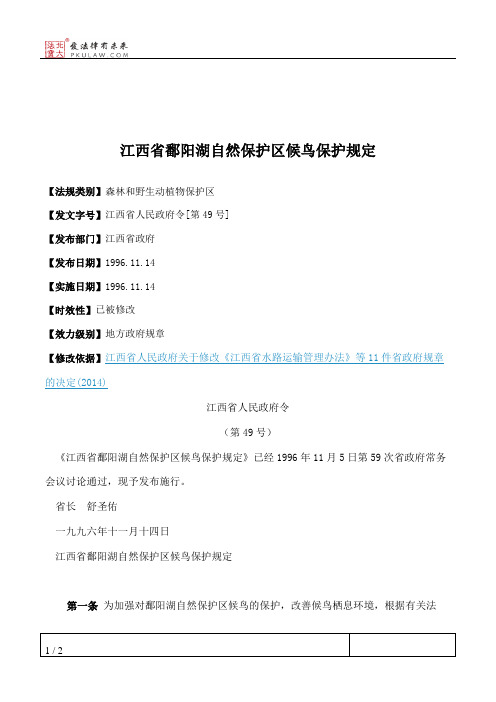
江西省鄱阳湖自然保护区候鸟保护规定【法规类别】森林和野生动植物保护区【发文字号】江西省人民政府令[第49号]【发布部门】江西省政府【发布日期】1996.11.14【实施日期】1996.11.14【时效性】已被修改【效力级别】地方政府规章【修改依据】江西省人民政府关于修改《江西省水路运输管理办法》等11件省政府规章的决定(2014)江西省人民政府令(第49号)《江西省鄱阳湖自然保护区候鸟保护规定》已经1996年11月5日第59次省政府常务会议讨论通过,现予发布施行。
省长舒圣佑一九九六年十一月十四日江西省鄱阳湖自然保护区候鸟保护规定第一条为加强对鄱阳湖自然保护区候鸟的保护,改善候鸟栖息环境,根据有关法律、法规,制定本规定。
第二条本规定所称鄱阳湖自然保护区(以下简称保护区)是指国务院批准的鄱阳湖国家级自然保护区,其范围包括大汊湖、蚌湖、沙湖、常湖池、大湖池、中湖池、梅西湖、朱市湖、象湖及各湖湖边草洲。
第三条凡在保护区范围内的单位、居民和进入保护区的人员均应当遵守《中华人民共和国野生动物保护法》、《中华人民共和国自然保护区条例》、《江西省实施》等法律、法规和本规定。
一切单位和个人都有保护候鸟及其栖息环境的义务,并有权对猎捕候鸟、破坏候鸟栖息环境的行为进行检举、控告。
第四条保护区所在地及周边地区各级人民政府应当加强对候鸟保护工作的领导,采取切实有效的措施,增强辖区内公民保护候鸟的意识。
第五条省林业行政部门负责对保护区候鸟的保护实施统一监督管理。
保护区管理机构负责保护区内的候鸟保护的日常工作。
保护区所在地及周边乡(镇)人民政府和县以上公安、工商、渔政、环保、水利、地矿等部门,应当在各自职责范围内,配合林业行政部门和保护区管理机构做好候鸟保护工作;支持、协助林业行政部门和保护区管理机构依法查处猎捕、买卖候鸟及破坏候鸟栖息环境的行为。
第六条保护区所在地各级人民政府及其有关主管部门,应当安排合适的农业开发项目,妥善安排保护区内单位和居民的生产、生活;对因保护候鸟造成的经。
白鹤与鄱阳湖的故事
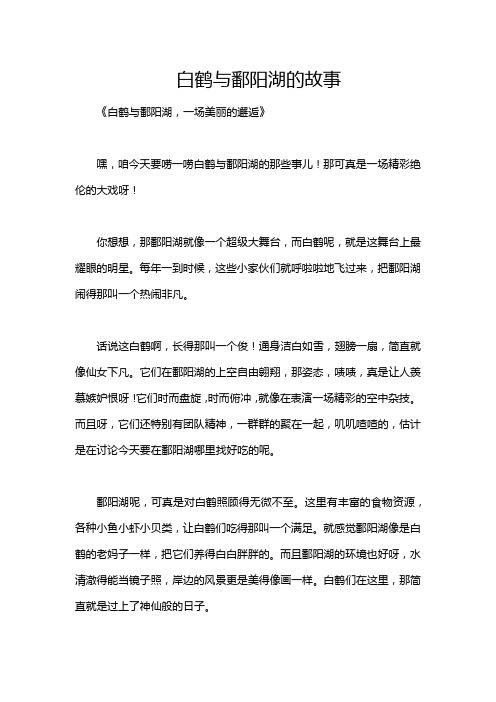
白鹤与鄱阳湖的故事《白鹤与鄱阳湖,一场美丽的邂逅》嘿,咱今天要唠一唠白鹤与鄱阳湖的那些事儿!那可真是一场精彩绝伦的大戏呀!你想想,那鄱阳湖就像一个超级大舞台,而白鹤呢,就是这舞台上最耀眼的明星。
每年一到时候,这些小家伙们就呼啦啦地飞过来,把鄱阳湖闹得那叫一个热闹非凡。
话说这白鹤啊,长得那叫一个俊!通身洁白如雪,翅膀一扇,简直就像仙女下凡。
它们在鄱阳湖的上空自由翱翔,那姿态,啧啧,真是让人羡慕嫉妒恨呀!它们时而盘旋,时而俯冲,就像在表演一场精彩的空中杂技。
而且呀,它们还特别有团队精神,一群群的聚在一起,叽叽喳喳的,估计是在讨论今天要在鄱阳湖哪里找好吃的呢。
鄱阳湖呢,可真是对白鹤照顾得无微不至。
这里有丰富的食物资源,各种小鱼小虾小贝类,让白鹤们吃得那叫一个满足。
就感觉鄱阳湖像是白鹤的老妈子一样,把它们养得白白胖胖的。
而且鄱阳湖的环境也好呀,水清澈得能当镜子照,岸边的风景更是美得像画一样。
白鹤们在这里,那简直就是过上了神仙般的日子。
但是啊,这美好的故事有时候也会有点小插曲。
比如说,有些坏人会来捣乱,试图伤害这些可爱的白鹤。
这可不行呀,咱得保护好这些小家伙,不能让它们受到伤害。
毕竟,它们可是鄱阳湖的宝贝,也是我们大家的宝贝呀!咱普通人能做的,就是多关注它们,爱护它们的家园。
看到有人伤害它们,咱就得勇敢地站出来。
让这些白鹤能每年都开开心心地来到鄱阳湖,和我们继续这场美丽的邂逅。
总之呢,白鹤与鄱阳湖的故事就是一部充满了欢乐、感动和责任的大片。
我希望这个故事能一直延续下去,让我们的子孙后代也能看到这美丽的场景。
让我们一起为白鹤和鄱阳湖加油,让这场邂逅永远不散场!哎哟喂,一想到那画面,我这心里就美得不行啦!。
鄱阳湖越冬候鸟品种

鄱阳湖越冬候鸟品种
鄱阳湖是中国重要的越冬候鸟栖息地之一,吸引了大量的候鸟在这里越冬。
以下是一些常见的在鄱阳湖越冬的候鸟品种:
1. 白头鹤:白头鹤是鄱阳湖最具代表性的越冬候鸟之一,呈现出美丽的白色羽毛和红色的嘴巴。
2. 鸳鸯:鸳鸯是一种漂亮的水鸭,雄性鸳鸯的头部呈现出独特的黑白相间的色彩,而雌性则呈现出灰色的羽毛。
3. 白眉鹨:白眉鹨是一种小型的候鸟,它们具有红褐色的背部和头部,眼部周围有白色的眉毛。
4. 大鸨:大鸨是一种大型的候鸟,具有浅褐色的羽毛和长长的腿,它们常常在鄱阳湖湿地中觅食。
5. 灰鹤:灰鹤是一种比较常见的候鸟,它们具有灰色的羽毛和黑色的嘴巴,常常在鄱阳湖湿地中觅食。
这些只是鄱阳湖越冬候鸟中的几个代表品种,还有其他许多鸟类也会选择在这里越冬。
鄱阳湖的湖泊、河流和湿地为候鸟提供了丰富的食物资源和安全的栖息地,吸引了大量的候鸟在这里度过寒冷的冬季。
江西鄱阳湖国家级自然保护区子湖泊越冬水鸟多样性及变化趋势
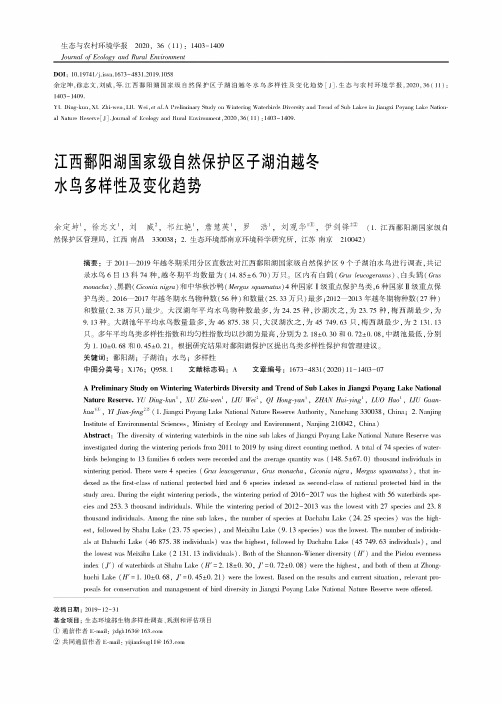
生态与农村环境学报2020,36(11):1403-1409Journal of Ecology and Rural EnvironmentDOI:10.19741/j.issn.1673-4831.2019.1058余定坤,徐志文,刘威,等•江西鄱阳湖国家级自然保护区子湖泊越冬水鸟多样性及变化趋势[J].生态与农村环境学报,2020,36(11):1403-1409.YL Ding-kun,XL Zhi-wen,LIL Wei,et al.A Preliminary Study on Wintering Waterbirds Diversity and Trend of Sub Lakes in Jiangxi Poyang Lake National Nature Reserve[J].Journal of Ecology and Rural Environment,2020,36(11):1403-1409-江西鄱阳湖国家级自然保护区子湖泊越冬水鸟多样性及变化趋势余定坤',徐志文1,刘威2,祁红艳1,詹慧英1,罗浩1,刘观华1①,伊剑锋2②(1.江西鄱阳湖国家级自然保护区管理局,江西南昌330038; 2.生态环境部南京环境科学研究所,江苏南京210042)摘要:于2011—2019年越冬期采用分区直数法对江西鄱阳湖国家级自然保护区9个子湖泊水鸟进行调查,共记录水鸟6目13科74种,越冬期平均数量为(14.85±6.70)万只。
区内有白鹤(Grus leucogeranus)、白头鹤(Grus monacha)、黑鹳(Ciconia nigra)和中华秋沙鸭(Mergus squamatus)4种国家I级重点保护鸟类,6种国家n级重点保护鸟类。
2016—2017年越冬期水鸟物种数(56种)和数量(25.33万只)最多;2012—2013年越冬期物种数(27种)和数量(2.38万只)最少。
我国最大的淡水湖

我国最大的淡水湖淡水湖是湖水含盐量较低的湖泊。
中国的淡水湖主要分布在长江中下游平原、淮河下游和山东南部,这一地带的湖泊面积约占全国湖泊总面积的三分之一。
那么我们国家最大的淡水湖是哪一个呢?--鄱阳湖鄱阳湖是中国第一大淡水湖,也是中国第二大湖,仅次于青海湖。
鄱阳湖隶属于上饶市,位于江西省北部、长江南岸,被称为“白鹤世界”、“珍禽王国”。
鄱阳湖隶属于上饶市。
位于江西省北部、长江南岸,介于北纬28度22分~29度45分,东经115度47分~116度45分,跨南昌、新建、进贤、余干、鄱阳、都昌、湖口、九江、星子、德安和永修等市县。
鄱阳湖也是世界上最大的鸟类保护区,每年秋末冬初,有成千上万只候鸟,从俄罗斯西伯利亚、蒙古、日本、朝鲜以及中国东北、西北等地来此越多。
如今,保护区内鸟类有300多种,近百万只,其中白鹤等珍禽50多种。
鄱阳湖被称为“白鹤世界”、“珍禽王国”。
2021年6月19日,鄱阳湖标志性水文站星子站水位突破警戒线。
鄱阳湖水文局及江西省水文局先后发布洪水蓝色预警。
经过漫长的历史年代,在地质、气象、水文等符合作用、长期发展下,彭蠡泽向南扩展,湖水越过松门山直抵鄱阳县附近,因而易名鄱阳湖。
在湖水南侵之前,松门山以南原本是人烟稠密的枭阳平原,随着湖水的不断南侵,鄱阳湖盆地内的枭阳县和海昏县治先后被淹入水中,历史上曾有“沉枭阳起都昌、沉海昏起吴城”之说。
烟波浩渺、水域辽阔的鄱阳湖,经过漫长的演变,在距今约1600年左右形成了现代鄱阳湖的雏形,犹如一只巨大的宝葫芦系在万里长江的腰带上。
鄱阳湖在古代有过彭蠡湖、彭蠡泽、彭泽湖、彭湖、扬澜湖、宫亭湖等多种称谓。
经过漫长的历史年代,在地质、气象、水文等符合作用、长期发展下,彭蠡湖泽向南扩展,湖水越过松门山直抵鄱阳县附近,因而易名鄱阳湖。
在湖水南侵之前,松门山以南原本是人烟稠密的鄡阳平原,随着湖水的不断南侵,鄱阳湖盆地内的鄡阳县和海昏县治先后被淹入水中,历史上曾有“沉鄡阳起都昌、沉海昏起吴城”之说。
在鄱阳湖越冬的东方白鹳的一些资料
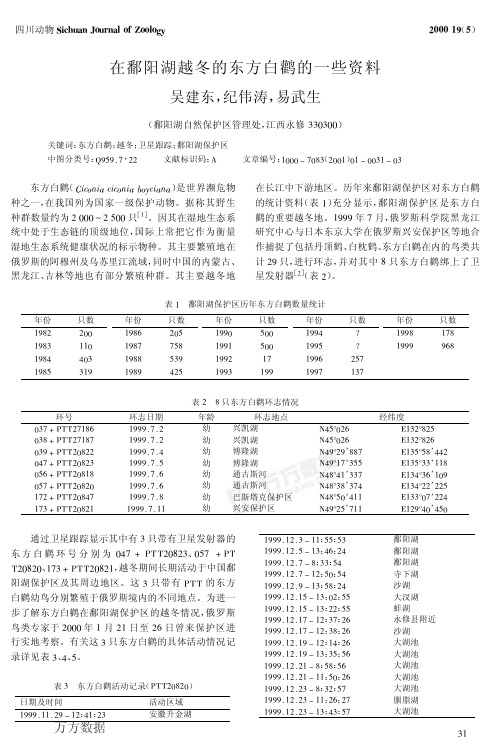
(4) 0111 23
在鄱阳湖越冬的东方白鹳的一些资料
吴建东, 纪伟涛, 易武生
(鄱阳湖自然保护区管理处, 江西永修 !!"!"")
关键词: 东方白鹳; 越冬; 卫星跟踪; 鄱阳湖保护区 中图分类号: #$%$ & ’ ( )) 文献标识码: * 文章编号: ()""+) +""" , ’"-! "+ , ""!+ , "!
统中处于生态链的顶级地位, 国际上常把它作为衡量 湿地生态系统健康状况的标示物种。其主要繁殖地在 俄罗斯的阿穆州及乌苏里江流域, 同时中国的内蒙古、 黑龙江、 吉林等地也有部分繁殖种群。其主要越冬地
表+ 年份 +$-) +$-! +$-/ +$-% 只数 )"" ++" /"! !+$ 年份 +$-0 +$-’ +$-+$-$ 只数 )"% ’%%!$ /)% 表) 环号 "!’ ( 12 2)’+-0 "!- ( 12 2)’+-’ "!$ ( 12 2)"-)) "/’ ( 12 2)"-)! "%0 ( 12 2)"-+"%’ ( 12 2)"-)" +’) ( 12 2)"-/’ +’! ( 12 2)"-)+ 环志日期 +$$$ 3 ’ 3 ) +$$$ 3 ’ 3 ) +$$$ 3 ’ 3 / +$$$ 3 ’ 3 % +$$$ 3 ’ 3 0 +$$$ 3 ’ 3;+ 年龄 幼 幼 幼 幼 幼 幼 幼 幼
鄱阳湖国家级自然保护区白鹤、东方白鹳和小天鹅种群数量与分布

鄱阳湖国家级自然保护区白鹤、东方白鹳和小天鹅种群数量与分布朱奇;刘观华;曾南京;吴建东;金杰锋;詹慧英【期刊名称】《湿地科学与管理》【年(卷),期】2012(0)4【摘要】2007-2009年期间的2个越冬期,对鄱阳湖国家级自然保护区白鹤Grus leucogeranus、东方白鹳Ciconia boyciana和小天鹅Cygnus columbianus种群数量和分布进行了监测与研究,结果表明这3个物种的数量一般都在12月达到最高,而10月由于候鸟刚刚迁来以及翌年3月已有部分候鸟迁离,故这2个月份鸟类数量相对较少.保护区的9个湖泊中,沙湖是白鹤、东方白鹳和小天鹅极重要的栖息地,而大湖池是东方白鹳和小天鹅极重要的栖息地.监测发现蚌湖已成为白鹤和东方白鹳重要的栖息地,建议将该湖划为保护区的核心区以加强白鹤等濒危物种的保护.%During the 2 winters of 2007 to 2009, a survey of Grus leucogeramis, Ciconia boycicma and Cygnus columbianus was conducted in Poyang Lake National Nature Reserve. The results indicated that the three species reached their peaks in number in December, and due to new arrivals of the migratory birds in October and departures in March the numbers of birds in these two months were small. In 9 lakes of the reserve, Shahu Lake was the very important habitat for Grus leucogeramis, Ciconia boyciana and Cygnus columbianus , and Dahuchi lake was the important habitat for Ciconia boyciana and Cygnus columbianus. Field monitoring showed that the lake Banghu had become an important wintering site for Grusleucogeranus and Ciconia boyciana, and in order to strengthen the protection of endangered species such as Grus leucogeramis, it was suggested that designating Banghu Lake as the core area of Poyang Lake National Nature Reserve.【总页数】4页(P53-56)【作者】朱奇;刘观华;曾南京;吴建东;金杰锋;詹慧英【作者单位】江西鄱阳湖国家级自然保护区管理局,南昌330038;江西鄱阳湖国家级自然保护区管理局,南昌330038;江西鄱阳湖国家级自然保护区管理局,南昌330038;江西鄱阳湖国家级自然保护区管理局,南昌330038;江西鄱阳湖国家级自然保护区管理局,南昌330038;江西鄱阳湖国家级自然保护区管理局,南昌330038【正文语种】中文【相关文献】1.鄱阳湖国家级自然保护区东方白鹳(Ciconia boyciana)种群数量变化与气候的关系 [J], 缪泸君;李言阔;李佳;谢光勇;袁芳凯2.近十年来鄱阳湖区越冬白鹤种群数量与分布 [J], 单继红;马建章;李言阔;钱法文;涂晓斌3.鄱阳湖小天鹅越冬种群数量与行为学特征 [J], 戴年华;邵明勤;蒋丽红;杜建华;蒋剑虹;曾宾宾4.山东黄河三角洲国家级自然保护区东方白鹳种群恢复与保护现状 [J], 连海燕5.鄱阳湖小天鹅越冬种群数量动态与空间分布格局 [J], 魏振华;李言阔;单继红;汪凌峰;丁红秀;应钦;钟毅峰;邵瑞清因版权原因,仅展示原文概要,查看原文内容请购买。
在鄱阳湖越冬的东方白鹳的一些资料

在鄱阳湖越冬的东方白鹳的一些资料吴建东;纪伟涛;易武生【期刊名称】《四川动物》【年(卷),期】2001(020)001【摘要】@@东方白鹳(Ciconia ciconia boyciana)是世界濒危物种之一,在我国列为国家一级保护动物。
据称其野生种群数量约为2 000~2 500只[1]。
因其在湿地生态系统中处于生态链的顶级地位,国际上常把它作为衡量湿地生态系统健康状况的标示物种。
其主要繁殖地在俄罗斯的阿穆州及乌苏里江流域,同时中国的内蒙古、黑龙江、吉林等地也有部分繁殖种群。
其主要越冬地在长江中下游地区。
历年来鄱阳湖保护区对东方白鹳的统计资料(表1)充分显示,鄱阳湖保护区是东方白鹳的重要越冬地。
1999年7月,俄罗斯科学院黑龙江研究中心与日本东京大学在俄罗斯兴安保护区等地合作捕捉了包括丹顶鹤、白枕鹤、东方白鹳在内的鸟类共计29只,进行环志,并对其中8只东方白鹳绑上了卫星发射器[2](表2)。
【总页数】4页(P30-33)【作者】吴建东;纪伟涛;易武生【作者单位】鄱阳湖自然保护区管理处,;鄱阳湖自然保护区管理处,;鄱阳湖自然保护区管理处,【正文语种】中文【中图分类】Q959.7+22【相关文献】1.鄱阳湖越冬季节东方白鹳栖息地选择及保护现状研究 [J], 王禹石;阮禄章;黄鹏;罗华星;陈绍萍2.鄱阳湖国家级自然保护区白鹤、东方白鹳和小天鹅种群数量与分布 [J], 朱奇;刘观华;曾南京;吴建东;金杰锋;詹慧英3.越冬地东方白鹳繁殖生物学的初步研究 [J], 杨陈;周立志;朱文中;侯银续4.鄱阳湖国家级自然保护区东方白鹳(Ciconia boyciana)种群数量变化与气候的关系 [J], 缪泸君;李言阔;李佳;谢光勇;袁芳凯5.越冬地东方白鹳的繁殖干扰 [J], 侯银续;周立志;杨陈;王岐山因版权原因,仅展示原文概要,查看原文内容请购买。
江西共青城市鄱阳湖区域非繁殖期鸟类多样性初步研究

江西共青城市鄱阳湖区域非繁殖期鸟类多样性初步研究戴年华;邵明勤;蒋剑虹;郭宏【期刊名称】《江西师范大学学报(自然科学版)》【年(卷),期】2014(038)001【摘要】2013年1-2月,采用样线和样点法相结合,对共青城市鄱阳湖区域3个点的鸟类资源进行了初步调查,共记录鸟类11目34科87种.国家Ⅰ级保护鸟类3种,即白头鹤(Grus monacha)、白鹤(Grus leucogeranus)和东方白鹳(Ciconia minutus),国家Ⅱ级保护鸟类5种.居留型方面,冬候鸟和留鸟居多,分别占物种数的45.98%和43.68%.鸟类区系方面,古北界种类最多,为47种占54.02%,其次是东洋界占32.18%.鸟类多样性指数为4.67,表明共青城鸟类物种资源十分丰富,是鄱阳湖国家级自然保护区外围西侧生态保护的重要补充区域.【总页数】7页(P19-25)【作者】戴年华;邵明勤;蒋剑虹;郭宏【作者单位】江西省科学院鄱阳湖研究中心,江西南昌330029;江西师范大学生命科学学院,江西南昌330022;江西师范大学生命科学学院,江西南昌330022;江西师范大学生命科学学院,江西南昌330022【正文语种】中文【中图分类】Q959【相关文献】1.鄱阳湖非繁殖期陆生鸟类多样性初步研究 [J], 石文娟;邵明勤;曾宾宾;蒋剑虹;赖宏清2.江西南矶山国家级自然保护区非繁殖期鸟类多样性研究 [J], 章旭日;邵明勤;许婷;简敏菲;倪才英;胡斌华3.鄱阳湖流域非繁殖期鸟类多样性 [J], 邵明勤;曾宾宾;徐贤柱;尚小龙;戴年华4.江西鄱阳湖共青城市区域鸟类多样性研究 [J], 戴年华;蒋剑虹;赖宏清;李畅;邵明勤;曾宾宾;尤鑫;姚忠;张杰5.新疆塔城市不同生境繁殖期鸟类多样性研究 [J], 丁鹏; 阴俊齐; 刘威; 时磊; 伊剑锋因版权原因,仅展示原文概要,查看原文内容请购买。
2011年冬鄱阳湖水鸟数量与分布调查_朱奇

鸟类名录分类体系参考郑光美 《中国鸟类分类与 分布名录》第二版(2011)[1]。
南昌市 南昌
余干 4
将调查所统计到的主要水鸟的数据与世界 1%种 群数量进行比较,该标准源自湿地国际于 2006 年公布 的《全球水鸟数量评估》第 4 版(WPE4),是目前最新的
整个调查区域包括鄱阳湖及相邻的赤湖、赛城湖 等区域,调查结果表明越冬水鸟主要集中在鄱阳湖内, 赤湖和赛城湖在此次调查中分别发现越冬水鸟 41 只 和 98 只,仅占整个水鸟总数的 2/10000。
根据“湿地公约”定义的相关标准,如果某一地点
单种水鸟数量超过全球种群数 1%的标准,那么这一 地点对该物种就具有国际重要意义。将调查到的水鸟 数量与最新公布的全球种群数 1%相比较 (详见表 3 标 * 号物种),此次调查中鄱阳湖共统计到 14 个种达 到或超过全球种群数 1%的标准,依次是:鸿雁(Anser cygnoides) 接近全球总数量估计值的 2 倍;白鹤(Grus leucogeranus)、东方白鹳(Ciconia boyciana)超过全球数 量的估计值;小天鹅(Cygnus columbianus)超过全球总 数量的 28%;白枕鹤 (Grus vipio) 超过全球总数量的 13%;反嘴鹬(Recurvirostra avasetta)超过全球总数量的
青脚鹬
Tringa nebularia
280
14050
* 罗纹鸭 Anas falcata
581
350
白腰草鹬 Tringa ochropus
198
19000
珍稀候鸟的天堂——鄱阳湖国家级自然保护区
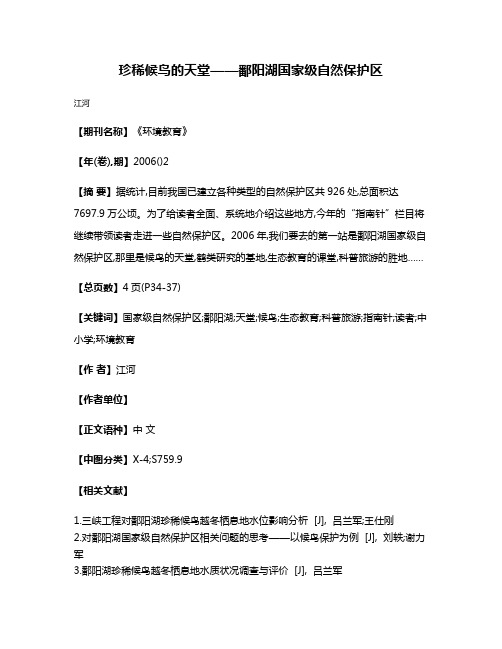
珍稀候鸟的天堂——鄱阳湖国家级自然保护区
江河
【期刊名称】《环境教育》
【年(卷),期】2006()2
【摘要】据统计,目前我国已建立各种类型的自然保护区共926处,总面积达7697.9万公顷。
为了给读者全面、系统地介绍这些地方,今年的“指南针”栏目将继续带领读者走进一些自然保护区。
2006年,我们要去的第一站是鄱阳湖国家级自然保护区,那里是候鸟的天堂,鹤类研究的基地,生态教育的课堂,科普旅游的胜地……【总页数】4页(P34-37)
【关键词】国家级自然保护区;鄱阳湖;天堂;候鸟;生态教育;科普旅游;指南针;读者;中小学;环境教育
【作者】江河
【作者单位】
【正文语种】中文
【中图分类】X-4;S759.9
【相关文献】
1.三峡工程对鄱阳湖珍稀候鸟越冬栖息地水位影响分析 [J], 吕兰军;王仕刚
2.对鄱阳湖国家级自然保护区相关问题的思考——以候鸟保护为例 [J], 刘轶;谢力军
3.鄱阳湖珍稀候鸟越冬栖息地水质状况调查与评价 [J], 吕兰军
4.候鸟眷舞珍禽恋歌鄱阳湖国家级候鸟自然保护区漫记 [J], 周琦
5.江西鄱阳湖区的珍稀候鸟 [J], 杨林元
因版权原因,仅展示原文概要,查看原文内容请购买。
近十年来鄱阳湖区越冬白鹤种群数量与分布

近十年来鄱阳湖区越冬白鹤种群数量与分布单继红;马建章;李言阔;钱法文;涂晓斌【期刊名称】《动物学研究》【年(卷),期】2012(033)004【摘要】Using simultaneous land surveys, we monitored the population size and spatial distribution of wintering Siberian cranes at 64 lakes around Poyang Lake between 1998 and 2010. The results showed that 46 lakes were inhabited by wintering cranes, and in 25 of those, the number of wintering cranes accounted for more than 1% of the Siberian cranes' global population. The lakes where over 40.0% of the global population, e.g. 1280 individuals, included Dachahu Lake in Jiujiang region, and Banghu Lake and Candouhu Lake in the Poyang Lake Nature Reserve. The average yearly population of the wintering Siberian crane in the Poyang lakes was 3108 + 849, with the maximum of 4004 individuals in winter 2002. On the whole, there was no drastic fluctuation, but population numbers have shown considerable fluctuation since 2003. We also found the Poyang Lake Nature Reserve was the major wintering area of the Siberian crane, with over 60% of Siberian cranes wintering in the reserve since 2002 (except in 2006). Most of the inhabited lakes are covered in existing nature reserves, though some lakes outside the reserve were also considerably used by Siberian cranes.%1998-2010年,该研究采用地面同步调查法在鄱阳湖区64个湖泊开展了越冬白鹤种群监测.结果表明,鄱阳湖区分布有稳定的越冬白鹤种群,鄱阳湖区越冬白鹤种群数量年平均值为(3108±849)只,2002年冬季达到最大值4 004只;从2003年开始鄱阳湖区越冬白鹤数量表现出一定的年际波动,但变化幅度较小.共有46个湖泊被记录到有白鹤活动.其中,达到全球白鹤种群数量1%标准以上的湖泊达25个;白鹤数量接近或超过全球白鹤种群数量的40%,即1 280只个体以上的湖泊包括鄱阳湖国家级自然保护区内的大汊池、蚌湖和蚕豆湖,以及保护区外的南湖.自然保护区涵盖了越冬白鹤的主要聚集湖泊.分布在自然保护区内的白鹤占鄱阳湖区越冬白鹤种群总数量的(66±27.3)%.保护区外分布的白鹤数量虽然总体呈下降趋势,但仍分布有一定数量的个体.【总页数】7页(P355-361)【作者】单继红;马建章;李言阔;钱法文;涂晓斌【作者单位】东北林业大学野生动物资源学院,黑龙江哈尔滨150040;东北林业大学野生动物资源学院,黑龙江哈尔滨150040;江西师范大学生命科学学院,江西南昌330026;中国林业科学研究院森林生态环境与保护研究所国家林业局森林保护学重点实验室,北京100091;江西省野生动植物保护管理局,江西南昌330046【正文语种】中文【中图分类】Q145;Q915.865【相关文献】1.鄱阳湖区域越冬雁鸭类分布与数量 [J], 涂业苟;俞长好;黄晓凤;单继红;孙志勇;汪志如2.鄱阳湖国家级自然保护区白鹤、东方白鹳和小天鹅种群数量与分布 [J], 朱奇;刘观华;曾南京;吴建东;金杰锋;詹慧英3.鄱阳湖区灰鹤越冬种群数量与分布动态及其影响因素 [J], 单继红;马建章;李言阔;钱法文;涂晓斌4.气候变化对鄱阳湖白鹤越冬种群数量变化的影响 [J], 李言阔;钱法文;单继红;李佳;袁芳凯;缪泸君;谢光勇5.鄱阳湖区反嘴鹬种群数量动态与空间分布格局 [J], 涂翔宇; 牟庆茹; 李言阔; 涂晓斌因版权原因,仅展示原文概要,查看原文内容请购买。
鄱阳湖天是鹤家乡

鄱阳湖天是鹤家乡2月的湖床上苔草将绿未绿,长期被水浸泡的湿地和初春的风都是湿漉漉的,但我和阿宽各持着一个长焦镜头就这样躺在地上,取景框里掠过的一群群被夕阳镶了金边的白鹤让我们忽略了其它一切。
这些来自西伯利亚的精灵经受着年复一年的迁徙“训练”,其飞翔姿态是何等的自由与优美!伴随着鹤阵悠长的唳叫声,相机快门声响成一片,明知胶片上记载的瞬间永远无法企及天空中这种灵动的美,但我们知道这些照片已足够打动身边的无数人。
发现才二十多年的“白鹤王国”2004年的长江中下游水鸟调查,使我有机会第一次近距离地来观察鄱阳湖――中国第一大淡水湖的壮丽景观与丰富生物。
一周多的时间里,我们盘桓在鄱阳湖区的几个自然保护区――这里有全球95%以上的越冬白鹤,从沙湖山到南矶山,从大湖池到蚌湖,我们拍摄到的物种名单上除了白鹤,还有长长的一串:白枕鹤、白头鹤、灰鹤、东方白鹳、黑鹳、小天鹅、白琵鹭、鸿雁……因此在之后的每年春节以后,我都会回到这片土地,履行我与候鸟们的一个个约定……白鹤又名西伯利亚鹤、黑袖鹤,是一种大型涉禽,主要在俄罗斯西伯利亚地区繁殖,在长江中下游地区越冬。
上世纪70年代末,作为全球鹤类研究的权威机构,国际鹤类基金会曾经宣布,世界上的白鹤仅剩有300多只,处于灭绝边缘。
正当世人为它的前途和命运担忧的时刻,鄱阳湖地区却传出了振奋人心的消息:1983年这里发现白鹤409只,1984年又发现840只。
1985年,包括国际鹤类基金会主席阿其波博士在内的国内外专家带着半信半疑的心情,纷纷来到鄱阳湖进行实地考察,当他们在鄱阳湖保护区的核心区大湖池看见了世界罕见的“鹤林”--长着粉红色长腿的白鹤,在阳光下犹如树干淡红的小树顶着洁白的树冠,密集地组成一条奇特的林带时,很多人激动得手舞足蹈,热泪纵横,连声惊呼“世界奇迹!”、“中国的第二座长城!”。
鄱阳湖由此成为全球知名的“白鹤王国”。
实际上鄱阳湖更是中国的“鸟类王国”,常年有300多种鸟类栖息,有13种鸟类列入世界濒危鸟类红皮书。
世界上最大的白鹤栖息地

世界上最大的白鹤栖息地白鹤,是我国重点保护的鸟类之一。
随着环境污染,繁衍成活率低,外来种类的竞争等多方面因素影响,白鹤已经濒临灭绝。
因此,保护濒危鸟类是每个公民义不容辞的责任。
下面店铺就为你介绍一下世界上最大的白鹤栖息地——鄱阳湖。
地理位置鄱阳湖位于北纬28°22′至29°45′,东经115°47′至116°45′。
地处江西省的北部,长江中下游南岸。
鄱阳湖以松门山为界,分为南北两部分,北面为入江水道,长40公里,宽3至5公里,最窄处约2.8公里;南面为主湖体,长133公里,最宽处达74公里,是中国第一大淡水湖,也是中国第二大湖。
有70%的水域在江西省九江市境内,其馀20%的水域在江西省上饶市境内,10%的水域在江西省南昌市境内。
汇集赣江、修河、鄱江(饶河)、信江、抚河等水经九江市湖口县城注入长江。
鄱阳湖上承赣、抚、信、饶、修五河之水,下接长江。
气候类型鄱阳湖是中亚热带范围内一个典型的湿地,这里既有大面积的湖洲草滩和水面,还有面积大小不等的岗丘、沙山和森林以及农田和庄园,这种水陆交替、独特而复杂的生态系统,孕育着众多的动植物。
适宜的气候,优良的水文条件和丰富的食物,吸引着无数的鸟类来此栖息,尤其是冬候鸟。
每到秋末冬初(11月),从前苏联西伯利亚、蒙古、日本、朝鲜、以及中国东北、西北等地,飞来成千上万只候鸟,这里已经成为了亚洲最大的候鸟越冬地。
它们和原来定居在这里的野鸭、鹭、鸳鸯等一起度过寒冷的冬天,直到翌年暮春(3月)才逐渐离去。
如今,保护区内共有鸟类332种,上百万只,其中珍禽达20多种,已是世界上最大的鸟类保护区。
尤其可喜的是在这里发现了当代世界上最大的白鹤群以及白枕鹤、白头鹤等,总数达4,000只以上。
鄱阳湖鸟类众多,被称为"珍禽王国",这里尤其以白鹤和白鹳闻名于世。
据统计1989年发现白鹤竟达2,600余只,占世界白鹤总数的百分之九十五,因此鄱阳湖又被称为"白鹤世界"。
- 1、下载文档前请自行甄别文档内容的完整性,平台不提供额外的编辑、内容补充、找答案等附加服务。
- 2、"仅部分预览"的文档,不可在线预览部分如存在完整性等问题,可反馈申请退款(可完整预览的文档不适用该条件!)。
- 3、如文档侵犯您的权益,请联系客服反馈,我们会尽快为您处理(人工客服工作时间:9:00-18:30)。
动 物 学 研 究2013,Dec. 34(6): 549−555 CN 53-1040/Q ISSN 0254-5853 Zoological Research DOI:10.11813/j.issn.0254-5853.2013.6.0549鄱阳湖国家级自然保护区东方白鹳(Ciconia boyciana)种群数量变化与气候的关系缪泸君,李言阔*,李佳,谢光勇,袁芳凯江西师范大学生命科学学院,江西南昌 330026摘要:该研究分析了1985—2011年鄱阳湖国家级自然保护区东方白鹳(Ciconia boyciana)越冬种群数量的年际变化趋势,探究了越冬地气候条件对其种群数量变化的影响。
结果表明,1985—2011年,保护区东方白鹳种群数量为(1 340±178)只,呈显著线性增长趋势,但年际波动较大。
种群数量与越冬当年11月份的平均最低气温显著正相关(r=0.554,P=0.003,n=27),越冬初期较低的温度可能影响东方白鹳选择鄱阳湖作为长期越冬地的决策,而增加对长江中、下游其他湿地的利用。
同时,越冬地气候条件对种群数量的影响存在显著的时滞效应。
越冬初期以及越冬后期的气温变量与2~9年后的种群数量显著正相关。
尤其是越冬初期10月份的气温变量与2~5年后的种群数量变化极显著相关,越冬后期2月和3月的气温变量分别与8年后和3年后的种数数量极显著正相关。
多元线性回归分析结果表明,2年前的10月平均最高温度、2年前的3月平均最高气温、4年前的10月平均最高温度、4年前的3月平均气温是东方白鹳种群数量变化的显著预测变量,共同解释了种群数量年际变化的79.2% (R2=0.792,F=20.901,df=26,P=0.000)。
越冬初期和末期可能是个体迁飞后补充能量和迁飞前积累能量的关键阶段,适宜的气温有利于成体的能量积累和幼体的存活,且东方白鹳性成熟年龄为2~6年,因此,越冬地气候条件对其种群增长的影响将会在2年后体现。
关键词:鄱阳湖;东方白鹳;种群数量波动;气候变化中图分类号:Q959.7 文献标志码:A 文章编号:0254-5853-(2013)06-0549-07The correlations between population of Oriental white stork and climate change in the Poyang Lake National Nature ReserveLu-Jun MIAO,Yan-Kuo LI,Jia LI,Guang-Yong XIE,Fang-Kai YUANCollege of Life Sciences, Jiangxi Normal University, Nanchang 33022, ChinaAbstract: This study analyzed the population dynamics of the Oriental white stork (Ciconia boyciana) wintering in the Poyang Lake National Nature Reserve (PLNNR) from 1985 to 2011, to see if there was any relationship with climate change. Testing of several climate variables—monthly average temperature, monthly average maximum and minimum temperature, as well as monthly precipitation—indicated that the population size of the Oriental white stork in the PLNNR was 1,340±178 ind., with significant linear increase and drastic annual fluctuation. Every single year, the population size only significantly correlated with the average minimum temperature of Nov. In theory, the low temperature of Nov. could drive individuals to choose other wetlands in the middle and lower reaches of the Yangtze River, instead of the Poyang Lake as wintering habitats. Meanwhile, temperatures in wintering areas also showed a carry-over effect on subsequent population size. Temperatures in primary stage and later stage of wintering period were significantly correlated with population size 2−9 years later, while the temperature of Oct. was highly significantly correlated with population size 2−5 years after. Temperatures of Feb. and Mar. in the later stage of wintering period were highly significantly correlated with population size of 8 and 3 years after, respectively. Moreover, the stepwise linear regression result showed that the average maximum temperature of Oct. and average maximum temperature of Mar. 2 years ago, as well as the average maximum temperature of Oct. and the average temperature of Mar. 4 years ago were significant predictor factors of the population size fluctuation of the Oriental white stork, which totally accounted for 79.2% of the population size change.Keywords: Poyang Lake; Oriental white stork; Population fluctuation; Climate change收稿日期:2013-09-27;接受日期:2013-10-24基金项目:国家自然科学基金 (31000196);“国家级自然保护区生态环境十年变化调查与评估”(环保重大专项,STSN-7)∗通信作者(Corresponding author),E-mail: liyankuo@550 动物学研究 34卷气候条件是影响生物生存的重要环境因子。
气候及其变化对种群数量波动的影响是鸟类学家关注的焦点之一。
近年来的研究表明,气候变化会对鸟类的种群数量动态产生较强的影响(Both et al,2006;Crick,2004)。
例如,极端气候事件可能会直接导致死亡率的迅速提高,甚至导致局部种群的灭绝(Schreiber et al,1984)。
天气条件也可能通过改变食物资源的数量和质量影响成体存活率和繁殖成功率,进而影响鸟类的种群数量(Cormont et al,2012)。
该影响具有一定的时滞性,即在生活史某一阶段的气候条件对种群的影响需经过一定的时间方才显现(Yalden & Pearce-Higgins,1997)。
某些留鸟成体的存活率与非繁殖期的天气条件存在显著相关性(Jones et al,2003),越冬期的不利天气将导致迁徙鸟类繁殖成功率下降,第二年种群数量下降。
譬如,大天鹅(Cygnus cygnus)在越冬地幼体的比例与上一年冬季的平均气温显著相关,冬季气温将影响后期的繁殖成功率(Nilsson,1979)。
大多数迁徙鸟类种群数量的年际变化主要受其繁殖地生存条件的影响,但也有研究发现某些迁徙鸟类的种群数量受其越冬地生存条件的影响,如水蒲苇莺(Acrocephalus schoenobaenus)、崖沙燕(Riparia riparia)及草鹭(Ardea purpurea)等(Peach et al,1991;Bryant et al,1995;Den Held,1981)。
对于雁鸭类等水禽,其后期的繁殖成功率还受越冬地和迁徙停歇地食物条件等因素的影响(Newton,2004)。
因此,迁徙鸟类种群动态制约因素研究需考虑繁殖地、越冬地及迁徙停歇地的环境条件。
东方白鹳(Ciconia boyciana)全球种群现存仅~3000只个体,被IUCN红皮书列为濒危物种(Birdlife International,2013),也是我国国家I级重点保护野生动物(China Wildlife Propagation Insti-tution for Protection,1989)。
东方白鹳繁殖地主要位于中国和俄罗斯交界的黑龙江和乌苏里江流域,越冬地为我国长江中、下游地区(Birdlife Internat-ional,2013)。
其中,鄱阳湖区是东方白鹳在长江中、下游地区的主要越冬地。
近年来,该区越冬东方白鹳种群数量表现出较大波动(Li et al,2011)。
本研究分析鄱阳湖国家级自然保护区(以下简称保护区)1985—2011年(27 a)越冬东方白鹳种群数量的年际变化与越冬地气候变化的相关性及时滞效应,以及基于越冬地气候条件的种群数量波动模型与种群波动趋势的拟合程度。
1材料与方法1.1研究地区概况鄱阳湖湿地是我国最大的淡水湖泊湿地,位于长江南岸的江西省北部(E115°49′~116°46′,N28°11′~ 29°51′)。
